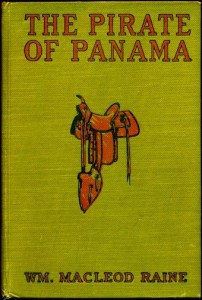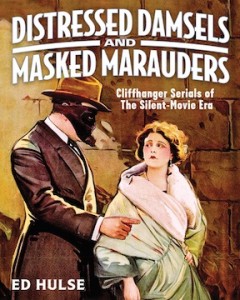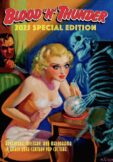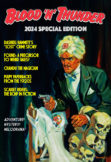EDitorial Comments
William MacLeod Raine’s THE PIRATE OF PANAMA (1913)
Readers of Blood ‘n’ Thunder are aware that I have a special interest in pulp yarns adapted for Hollywood movies of the silent and early-talkie eras. So you can imagine how eager I was to tackle a recently acquired copy of William MacLeod Raine’s The Pirate of Panama, which was serialized in three January 1914 issues of The Cavalier before seeing publication in book form by G. W. Dillingham Company later that year: I knew this novel to be the source for a 1929 Universal chapter play of the same title.
Raine had been writing fiction since the closing years of the previous century and was a regular contributor to such prominent periodicals as The Argosy, The All-Story, Pearson’s Magazine, People’s Magazine, and The Popular Magazine. The latter published several of his early Western novels, including Wyoming and A Texas Ranger. In fact, by 1914 Raine was already well known as a top hand in the Western genre, so The Pirate of Panama represented quite a departure even at that relatively early point in his career.
 The story is narrated by its protagonist, Jack Sedgwick, a young San Francisco lawyer who craves adventure. One morning, while on his way to work, Jack glances up at an apartment building and sees a young woman arguing with a somewhat older man over a piece of paper. She flings this document out the second-floor window rather than surrender it to her agitated tormentor. Sedgwick watches the paper flutter downward and picks it up. A cursory examination reveals it to be a treasure map. Shocked by this discovery, the young lawyer continues his commute in something of a trance.
The story is narrated by its protagonist, Jack Sedgwick, a young San Francisco lawyer who craves adventure. One morning, while on his way to work, Jack glances up at an apartment building and sees a young woman arguing with a somewhat older man over a piece of paper. She flings this document out the second-floor window rather than surrender it to her agitated tormentor. Sedgwick watches the paper flutter downward and picks it up. A cursory examination reveals it to be a treasure map. Shocked by this discovery, the young lawyer continues his commute in something of a trance.
The man in the window, having seen this, dashes downstairs and pursues Jack, who eludes him by hopping aboard a streetcar. Raine contrives — rather unconvincingly, I might add — a subsequent meeting of the two at a local restaurant, where the deep-dyed villyun recognizes Sedgwick as the retriever of the map. Once again he gives pursuit, once again the lawyer evades him.
Returning to his office, Jack is surprised by the presence of a visitor: the lady in the apartment-house window, who introduces herself as Evelyn Wallace. The map, she explains, was procured by her late father in his youth. It gives the location of buried treasure in Panama. Evelyn identifies the villain as her second cousin, a half-Scotch, half-Russian soldier of fortune named Boris Bothwell.
At this point — another contrived coincidence — the suavely sinister Bothwell turns up at Jack’s office and none too subtly demands the map. Like any good, red-blooded pulp-fiction hero Sedgwick refuses, gallantly casting his lot with the pretty girl instead. Boris warns Jack that he’s in for trouble and storms out. After thanking her champion, Evelyn gratefully accepts his offer of assistance in finding and retrieving the treasure.
In short order Jack rounds up an excitement-loving crew of compatriots led by wealthy Sam Blythe, who allows the expedition to sail aboard his yacht Argos. One of Sam’s acquaintances, a two-fisted ex-cowpuncher named Ted Yeager, comes along for the fun of it. Unbeknownst to any of them at the voyage’s beginning, the vessel also carries two stowaways: Jack’s office boy Jimmie and Boris Bothwell. The latter, having formed an alliance with one of the crew members, foments a mutiny once the ship gets underway.
A big chunk of the book is devoted to the struggle between rival factions vying for control of the Argos while it is en route to Panama. The mutineers are finally crushed after making several attacks and Bothwell is imprisoned in a cabin. Raine’s descriptions of the pitched battles are quite vivid and leave little to the imagination.
Not surprisingly, upon finally reaching the Panamanian shore Sedgwick and his friends run into more difficulty: Shifting sands have obscured landmarks pointing to the treasure’s burial spot; when found the unearthed chest turns out to be empty; and Bothwell escapes with the aid of a former co-conspirator. Jack, Sam, Ted and their allies eventually locate the loot, and Boris confronts the young lawyer one last time. In the knock-down, drag-out brawl that follows, Sedgwick is nearly bested before Bothwell is shot in the back by a disgruntled mutineer. Needless to say, Jack and Evelyn have fallen madly in love with each other, and all’s well that ends well.
Having enjoyed the Raine Westerns I’ve read, I had surprisingly mixed feelings about The Pirate of Panama. The writing is uncharacteristically uneven for this author; much of the book reads like a dime novel. The romantic interludes are particularly cloying, and there’s way too much dialogue of the curse-you-Jack-Dalton variety. Sedgwick is a personable protagonist, but his comrades Blythe and Yeager are more interesting and capable characters.
 Universal Pictures adapted The Pirate of Panama into a 12-chapter serial in 1929. It starred Jay Wilsey (the erstwhile “Buffalo Bill Jr.” of countless Westerns) as Jack, Natalie Kingston as Evelyn, and Al Ferguson as Boris. Although the serial is a lost film, I matched episode synopses published contemporaneously in Universal Weekly with the novel to see how much of Raine’s work survived in the scenario written by George Morgan and Arthur Henry Gooden. Basically, the serial’s first three chapters — constituting a fourth of the total running time — track events depicted in the first two thirds of Raine’s novel. Morgan and Gooden then spin off a series of digressions, padding out their narrative and only returning to the original yarn for the last chapter. I suspect the novel came to Universal’s attention when Grosset & Dunlap, which in the late Twenties was reprinting Raine’s Westerns in 75-cent editions, issued their version of the Dillingham hardcover edition. Apparently, G&D’s art director didn’t realize that Pirate of Panama wasn’t a Western, as the cloth cover bore the same “saddle” graphic found on Raine’s horse operas published by the company.
Universal Pictures adapted The Pirate of Panama into a 12-chapter serial in 1929. It starred Jay Wilsey (the erstwhile “Buffalo Bill Jr.” of countless Westerns) as Jack, Natalie Kingston as Evelyn, and Al Ferguson as Boris. Although the serial is a lost film, I matched episode synopses published contemporaneously in Universal Weekly with the novel to see how much of Raine’s work survived in the scenario written by George Morgan and Arthur Henry Gooden. Basically, the serial’s first three chapters — constituting a fourth of the total running time — track events depicted in the first two thirds of Raine’s novel. Morgan and Gooden then spin off a series of digressions, padding out their narrative and only returning to the original yarn for the last chapter. I suspect the novel came to Universal’s attention when Grosset & Dunlap, which in the late Twenties was reprinting Raine’s Westerns in 75-cent editions, issued their version of the Dillingham hardcover edition. Apparently, G&D’s art director didn’t realize that Pirate of Panama wasn’t a Western, as the cloth cover bore the same “saddle” graphic found on Raine’s horse operas published by the company.
Are there any other William MacLeod Raine fans out there? If so, send me a comment and let us know which of his stories you particularly like — or dislike.
Upcoming Murania Press Titles
With two new issues of Blood ‘n’ Thunder shipping and this site finally up and running, I’m now working on future additions to the Murania Press product line. This post is by way of a quick preview: With the exception of the first-named, the books described below will debut at this year’s PulpFest, about which you’ll be hearing more in the weeks ahead.
 Next up (finally, he said, after many months) is the several-times-postponed Distressed Damsels and Masked Marauders, my history of cliffhanger serials of the silent-movie era. The delay in getting this book to market is a source of considerable embarrassment to me; only once before in 32 years of professional writing have I had so much trouble with a project. Listing the reasons — which are both myriad and variegated, believe me — would at this late date seem like excuse-making, so I won’t do it. Suffice to say that, upon leaping one last production hurdle, Damsels goes out next month. To those of you who pre-ordered it an apparent eternity ago, I can only offer thanks for your patience. For what it’s worth, you’ll be getting a Damsels that’s measurably superior to the one you would have received had I made the original publication date: During those periods in which the book was sidelined, I added newly discovered information and photos that enhanced the product. As soon as the pre-ordered copies ship I’ll post a notice here to that effect.
Next up (finally, he said, after many months) is the several-times-postponed Distressed Damsels and Masked Marauders, my history of cliffhanger serials of the silent-movie era. The delay in getting this book to market is a source of considerable embarrassment to me; only once before in 32 years of professional writing have I had so much trouble with a project. Listing the reasons — which are both myriad and variegated, believe me — would at this late date seem like excuse-making, so I won’t do it. Suffice to say that, upon leaping one last production hurdle, Damsels goes out next month. To those of you who pre-ordered it an apparent eternity ago, I can only offer thanks for your patience. For what it’s worth, you’ll be getting a Damsels that’s measurably superior to the one you would have received had I made the original publication date: During those periods in which the book was sidelined, I added newly discovered information and photos that enhanced the product. As soon as the pre-ordered copies ship I’ll post a notice here to that effect.
As mentioned above, PulpFest will serve as the launching pad for several Murania Press books in addition to the jumbo-sized Tenth Anniversary issue of BnT, the full contents of which I still haven’t locked in. But you can count on seeing at least two more volumes in the Classic Pulp Reprints series: Pirates of the Pines and The Wilderness Trail.
A. M. Chisholm’s Pirates of the Pines originally appeared under another title in the October 20, 1915 issue of Street & Smith’s The Popular Magazine. It was recommended to me by pulp collector Walker Martin while I was researching The Popular for a lengthy BnT survey printed in issues 24 and 25. A rousing yarn set in the Canadian Northwest, Pirates is a vastly entertaining read by pulp-fiction standards, but what makes it really special is the novel conceit that sold Popular editor Charles Agnew MacLean on the tale to begin with: Chisholm designed it to parallel Treasure Island in every particular save locale. Plot, structure, characterization — all track Stevenson’s classic adventure. The narrator is a Jim Hawkins type. There’s a Long John Silver type, a Squire Trelawney type, a Ben Gunn type, and so on. The story progresses at a similar pace with action setpieces appearing at roughly the same intervals. It’s a brilliant tour de force by the prolific Chisholm, totally forgotten today but for many years one of MacLean’s most reliable contributors. What impressed me most about Pirates was the author’s success in putting his own stamp on the story. It can be enjoyed whether one has read Treasure Island or not, but familiarity with Stevenson’s work enhances the experience. For reasons unfathomable, Pirates of the Pines never had book publication…until now. I’m delighted to be bringing it out of the shadows and into the light.
The Wilderness Trail also deals with piracy — piracy along the Ohio River in the early years of the 19th century. This red-blooded yarn by H. Bedford-Jones initially appeared in the February 1915 issue of Blue Book and was the first of some 360 HB-J stories to see print in that prestigious pulp over a 34-year period. It also was his first historical adventure with an American setting and includes such famous figures as Daniel Boone, Zachary Taylor, John Audubon, and the Shawnee Indian chief Tecumseh among the prominent supporting characters. Although many Bedford-Jones pulp novels were published in the US as books, The Wilderness Trail wasn’t one of them. (It did, however, achieve release as a 1925 British hardcover issued by Hurst & Blackett Ltd.) Murania’s trade paperback will be the first American edition of this superb story long coveted by collectors of the astoundingly prolific and popular Bedford-Jones.
Finally, PulpFest will see the introduction of The Best of Blood ‘n’ Thunder: Volume Two, a follow-up to last year’s Volume One, which also debuted at PulpFest. I hadn’t planned on offering a sequel, but with all issues before 22 out of print, recent subscribers and purchasers of Volume One have deluged me with pleas for another compilation from back issues they can’t find. Material from the first ten issues was included in the first book; Volume Two will reprint most articles from numbers 11 to 21 in the same format as its predecessor.
I expect to publish other books in 2012, although not in time for unveiling at PulpFest. But it’s my hope that you’ll be interested in the three titles described above.
A Little More Patience, Please!
I realize you subscribers are waiting with baited breath for the latest issues of Blood ‘n’ Thunder, and I assure you they’ll be arriving soon. My involuntary hiatus might have raised Ned with Murania’s publishing schedule, but it also (perhaps I should say eventually) enabled me to finish this long-delayed site and update my subscriber database, which needed far more revision than I once thought.
Hopefully, the new configuration of said database will prevent individual copies and orders from falling between the cracks, so to speak, as was the case with issues 29 and 30. A well-meaning friend helped me with shipments of those numbers during stretches when I was incapacitated, but she couldn’t make sense of all my records or process all the renewals which came in during that lengthy period.
Copies of each new issue are sent out in batches because there are too many subscribers and wholesale clients for me to service all at once. Therefore, some of you get the latest BnT several weeks after others do. Once upon a time all my subscribers and most of my retail customers received their shipments within ten days to two weeks of publication. Without a staff — or at least a full-time helper — I can’t initially guarantee the same rapidity of service. But I’m convinced the new database will, in the long run, prove easier to manage, so please cut me a little slack until the shipping process returns to well-oiled-machine status. And it will, I promise.
As I always say, running a one-man publishing empire isn’t all it’s cracked up to be. But believe me, you’ll find the two most recent issues well worth the wait.
More Collectibles Added Today
Late this afternoon I posted another 13 sale items to Collectibles, bringing the current total to 21. I hope to add at least several pieces every day for the next week or two, so you should check that page frequently.
Please remember that all prices include the cost of shipping, handling, and packing materials. Once you click that “Add to Cart” button, you’re good to go — no additional charges.
Collectibles for Sale
When visiting the Murania Press site — something I hope you’ll do often — be sure to check the Collectibles page for new listings. As I write these words, with the site just about to launch, there’s only a handful of items available. But I intend to add many more in the coming days. You’ll find all sorts of goodies: pulps, hardcovers, vintage paperbacks, original movie memorabilia, reference works, and much more. And each item’s price will include the cost of shipping.
Time to Update Your Subscription!
Copies of the two new issues of Blood ‘n’ Thunder (numbers 31/32 and 33) are currently being shipped, so if you’re among our subscribers who are still in arrears, now’s the time to catch up. Besides, you won’t want to miss the upcoming big Tenth Anniversary issue, which debuts at PulpFest this August — and about which you’ll be reading here in the weeks and months ahead.
In case you don’t remember, a one-year, four-issue subscription to BnT costs just $40. With single copies priced at $11.95 plus $2.00 for shipping, that’s a significant savings. We hope to add an easy, one-click renewal option to this site, but for the time being you can re-up by making a Paypal payment of $40 to muraniapress@yahoo.com.
“So, what’s a Murania, anyway?”
The first book published under the auspices of Murania Press was The Blood ‘n’ Thunder Guide to Collecting Pulps, which came to market in the fall of 2007 (and which, by the way, is being revised and expanded for republication later this year). Since then, I’ve probably been asked a hundred times or more, “What’s Murania? Where did you come up with that name?”
The answer would come as no surprise to hard-core serial fans, who know Murania as a futuristic city located some 20,000 feet underground in the desert Southwest. Ruled by an evil queen who hoped to keep its existence secret from “those stupid surface people,” Murania figured prominently in The Phantom Empire, a 1934 Mascot Pictures chapter play that launched the starring career of singing cowboy Gene Autry. One of the most bizarre serials ever made, it was said to have been inspired by a dream that came to actor/writer Wallace MacDonald while under anesthesia at his dentist’s office. The Phantom Empire defied cliffhanger convention repeatedly, mixing Western, musical, comedic, and science-fictional ingredients into a surrealistic stew of daffy but endearing entertainment. The serial enjoyed considerable success during its two-year theatrical playoff period, prompting producer Nat Levine to put Autry into a series of feature films released by the newly formed Republic Pictures, which absorbed Mascot in 1935. The rest, as they say, is history. Autry went on to become one of Hollywood’s biggest box-office draws; in the late Thirties his popularity was comparable to that of such superstars as Clark Gable and Shirley Temple.
The Phantom Empire became a staple of early TV and was still being aired in 1963, the year I first saw it. At the time I wasn’t particularly interested in old Westerns, but the chapter play’s science-fictional elements called to me. Goofy beyond belief, even more so than many serials of the period, it appeals to the sense of wonder in much the same way that pulps, comic books, and old-time radio melodrama appealed to Depression-era audiences. When I decided to publish books and magazines covering American popular culture of those halcyon days, Murania Press was literally the first title that came to mind for my new imprint. I registered the domain name long before I put this site together.
To me, The Phantom Empire still symbolizes everything that’s fun about the vintage fiction and film I not only enjoy and collect but study as well. The ten-year-old boy in me still wants to believe that Murania exists, and every few years I revisit the serial — which, by the way, is available in a handsome but inexpensive DVD edition from VCI Entertainment.
At Long Last . . .
Well, it’s certainly been a long time coming, but the Murania Press web site is finally here, and I hope you visit frequently.
Originally, I planned to discuss and promote my zine Blood ‘n’ Thunder on a Blogspot page cleverly (or so I thought) titled Blog ‘n’ Thunder. I registered the name and created a template but never actually launched the thing. As explained in the “EDitorial Comments” page of BnT’s recent double issue, the last two years have been extremely hard on me for a variety of reasons, and I gradually lost that initial sense of urgency about getting the blog up and running. Now, having finally emerged from the long, dark tunnel I’ve been traversing lo these many months, I’m determined to get Murania Press on a fast track. Hence the site you’re visiting for the first time.
In addition to Blood ‘n’ Thunder – ostensibly, if not in actuality, a quarterly magazine – Murania Press has published other books and periodicals, and many more are in development. You can keep abreast of upcoming titles by checking back on a regular basis. But the site’s blog page won’t be reserved solely for shameless self-promotion; you’ll be able to access new-release details on other pages. Here I also plan on covering topics that will interest those of you who, like me, share a passion for adventure, mystery and melodrama in storytelling media of the late nineteenth and early twentieth centuries.
Story papers, dime novels, nickel weeklies, pulp magazines, slick magazines, hardcover novels, motion pictures, comic strips, radio dramas, early paperback originals—I love ‘em all. One blog post might cover a pulp I just read, the next an old movie I recently revisited. Hopefully my observations and appraisals will provoke discussion and debate. It seems to me there’s increasingly less intelligent conversation on message boards devoted to the study and appreciation of vintage pop culture. These days, off-topic diversions consume far more bandwidth than was the case years ago, when the ‘net brought so many of us together.
One venerable Yahoo group formed for devotees of vintage pulp fiction has been hijacked by a cadre of SF (Science Fiction, to you newbies) fans with little or no interest in the old rough-paper magazines. An endless string of inquiries about author estates now dominates the board, which not so many years ago boasted frequent participation from pulp fandom’s leading lights. It’s my fervent hope that this blog will recapture the enthusiasm of those heady days. I’d like nothing more than to find my posts eliciting lively comments from a faithful following of fellow fans. (Even if only to criticize my penchant for alliteration.) Guess I’ve got my work cut out for me. Stay tuned.
Recent Posts
- Windy City Film Program: Day Two
- Windy City Pulp Show: Film Program
- Now Available: When Dracula Met Frankenstein
- Collectibles Section Update
- Mark Halegua (1953-2020), R.I.P.
Archives
- March 2023
- July 2021
- May 2021
- March 2020
- February 2020
- December 2019
- November 2019
- October 2019
- September 2019
- August 2019
- May 2019
- April 2019
- March 2019
- February 2019
- December 2018
- November 2018
- October 2018
- August 2018
- June 2018
- February 2018
- December 2017
- October 2017
- September 2017
- August 2017
- May 2017
- April 2017
- February 2017
- September 2016
- August 2016
- July 2016
- June 2016
- November 2015
- October 2015
- September 2015
- August 2015
- July 2015
- June 2015
- May 2015
- April 2015
- March 2015
- February 2015
- January 2015
- August 2014
- July 2014
- June 2014
- May 2014
- April 2014
- January 2014
- December 2013
- September 2013
- August 2013
- July 2013
- June 2013
- May 2013
- April 2013
- March 2013
- February 2013
- January 2013
- December 2012
- October 2012
- September 2012
- August 2012
- July 2012
- June 2012
- May 2012
Categories
- Birthday
- Blood 'n' Thunder
- Blood 'n' Thunder Presents
- Classic Pulp Reprints
- Collectibles For Sale
- Conventions
- Dime Novels
- Film Program
- Forgotten Classics of Pulp Fiction
- Movies
- Murania Press
- Pulp People
- PulpFest
- Pulps
- Reading Room
- Recently Read
- Serials
- Special Events
- Special Sale
- The Johnston McCulley Collection
- Uncategorized
- Upcoming Books
- Western Movies
- Windy City pulp convention
Dealers
Events
Publishers
Resources
- Coming Attractions
- Field Guide to Wild American Pulp Artists
- MagazineArt.Org
- Mystery*File
- ThePulp.Net






